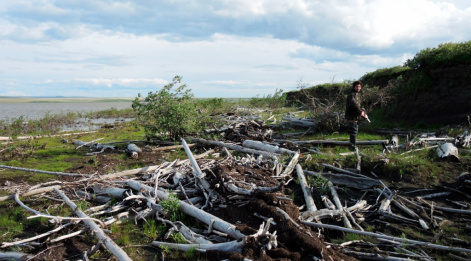Ocean currents will no longer supply Iceland with valuable driftwood from Russia
28 June 2022 г.

Felled or fallen trees, moving along rivers and seas and washed ashore, have long been the main building material for the inhabitants of the Arctic latitudes. For example, the Russian coast-dwellers built houses and fishing huts on the northern sea-shores from driftwood, and on the Svalbard archipelago driftwood has been the only available building material. Iceland was covered with birch forests before the arrival of man on the island, but rather quickly natural forests were cut down, and stunted shrubs took their place.
An international team of scientists, including a researcher from Krasnoyarsk, analyzed almost three hundred driftwood samples collected on the northern coast of Iceland. Based on 240 local chronologies of the width of the tree rings of the boreal zone of Russia, the scientists concluded that most of the Iceland’s driftwood is represented by Angara pine, which grows on the banks of the Yenisei and Angara rivers.
“For Iceland, which does not have its own forests, the driftwood has long been the most important resource: a building material for not only outbuildings, but also for building houses, and it is also used as fuel. The delivery of timber by water currents was performed along small and large rivers of Russia, even to the ports of Igarka and Dudinka. Sometimes the rafts, having fallen into a storm, crashed, some trees sank, but others, picked up by ice in the Arctic Ocean, after many years still reached the inhabited shores, ” says Doctor of Biological Sciences, researcher at the Sukachev Institute of Forest SB RAS and Siberian Federal University, Alexander Kirdyanov.
The age of the oldest tree studied during the research, according to the scientist, is more than 400 years. It is interesting that up to 20% of the driftwood that came from the Angara-Yenisei basin to Iceland is “natural” wood which got into the riverbeds due to natural causes not directly related to human industrial activity. At the same time, the amount of the Angara driftwood entering Iceland has declined sharply since the late 1980s.
“In the second half of the 1980s, the concept of transporting harvested wood in Russia changed, in particular, sawn wood was no longer transferred by water, and began to be increasingly transported using barges and self-propelled ships. In the 1990s, the port of Igarka almost ceased to operate, the timber industry enterprises of the Krasnoyarsk Region closed or slowed down the harvesting rate. Accordingly, the amount of “wandering” wood reaching the coast of Iceland through the Arctic Ocean has significantly decreased,” explains Alexander Kirdyanov.
Despite changes in the character of economic activity, as well as in the structure of currents in the Arctic Ocean, according to the authors of the article, global warming also affects the transport of the driftwood. In the near future, its transport will be affected by the retreat of the boundary of multi-year Arctic ice to the north, associated with global warming and the accompanying melting of Arctic glaciers. According to the results of mathematical modeling performed by the scientists from Iceland, the Czech Republic, Great Britain and Switzerland, by 2060 driftwood, in particular the Angara pine from Siberia, will hardly reach to the northern coast of Iceland.
When preparing the material, use was made of the text of the press service of the Siberian Federal University.
Share:
